Blockchain Business News 1-7 March
This is the weekly wrap of blockchain business news for 1-7 March. Subscribe to get the news you need for your business!
RubiX announced full-scale NFT launchpad
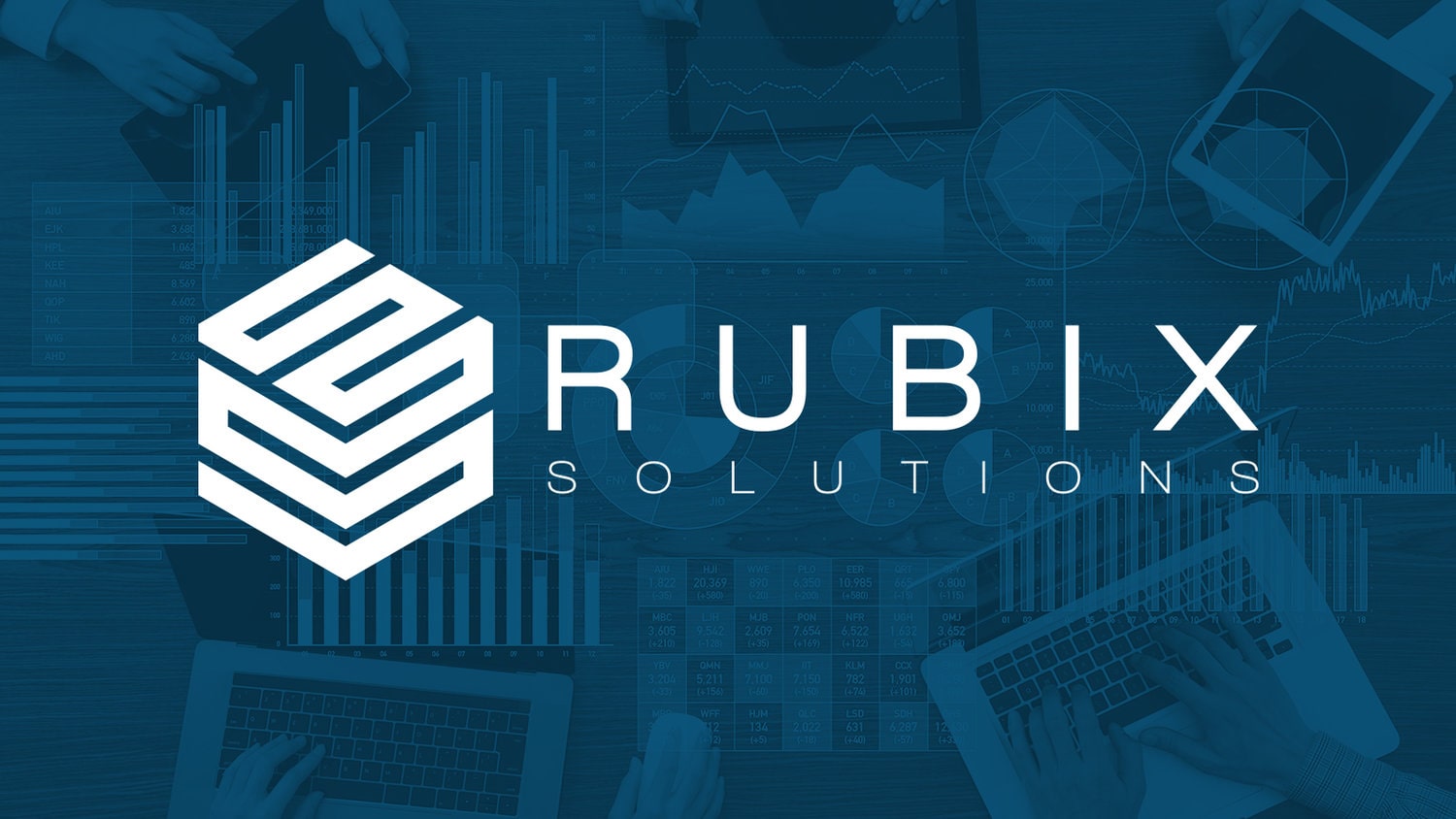
RubiX is a full-scale Blockchain-as-a-Service (BaaS) and security solutions company. The company was established in 2012 and has recently migrated all of its solutions to its own open source blockchain. Read more on the BaaS market.
The BaaS company has announced the launch of its Non-Fungible Tokens (NFT) application. The application is built on the highly-scalable RubiX blockchain backed by proprietary QR Code technology that secures, authenticates and proves ownership of digital and tangible assets.
With its application, RubiX is aiming “to make NFT more accessible to our enterprise partners and general consumers.”
The RubiX blockchain is several times stronger than Bitcoin and Ethereum. Each transaction is completed within ~250ms.
RubiX NFT is a digital asset that can be applied to industries including sports merchandise and memorabilia, luxury goods, real estate and financial institutions like asset management, insurance, payments and fintech.
VTB and Gazprom Neft launched Smart Fuel, a Blockchain-Enabled Payments

VTB or Vneshtorgbank was established in 1990 in Russia to service the country’s foreign economic transactions and promote its integration into the global economy.
Gazprom Neft, a subsidiary of Gazprom, is the third largest oil producer in Russia.
Gazprom Neft’s aviation refueling business is operated by Gazprom Aero. Gazprom Aero has recently launched Smart Fuel, a revolutionary approach to aircraft refueling.
Smart Fuel is a digital payment system which allows airlines to instantly pay for the fuel directly through fully secure financial transactions in real time, 24/7.
The technology has reduced the transaction time from 4-5 days to just a few minutes, while also significantly cutting down on airlines’ costs.
AC Milan raised over $6 million with their $ACM Fan Token

Italian soccer club AC Milan has become the latest sports team to take advantage of the crypto movement.
The team has debuted with their $ACM Fan Token on Binance, the world’s biggest cryptocurrency exchange. In just a few hours, the team had raised more than $6 million in new digital revenue.
The $ACM Fan Token is on the Chiliz blockchain-based fan engagement platform Socios.com. Fan Token holders have access to a range of club benefits, including the right to vote in polls, VIP rewards, exclusive club and sponsor promotions, games, chat and ‘super-fan’ recognition.
Amazon supports Ethereum on its AWS platform

Amazon Web Services has launched an enhanced version of its Amazon Managed Blockchain service that features support for the popular Ethereum blockchain platform.
Amazon Managed Blockchain allows customers to encrypt Ethereum transaction data both at rest and while it’s traversing the network.
The service also includes tools that companies can use to continuously synchronize transaction data from their nodes with the other nodes that make up the public Ethereum main network.
Ethereum is the second blockchain platform that AWS has made available on the service. Amazon Managed Blockchain also supports Hyperledger Fabric, which is maintained by the Linux Foundation and targets the enterprise market.
Blockchain reached space

JP Morgan has successfully tested a blockchain transaction in space using Danish space firm GomSpace’s satellites.
It is the world’s first bank-led tokenised value transfer in space, executed via smart contracts on a blockchain network, established between satellites orbiting the earth.
The transaction was executed between two GOMX-4 satellites in the low Earth orbit (LEO), which validated the approach towards a decentralised network where communication with the earth is not necessary.
Hive Blockchain Sees Crypto Mining Income increase by 174%

Hive Blockchain (HIVE) is a publicly traded cryptocurrency mining firm. The firm benefited from the bull market in digital assets last quarter as bitcoin (BTC) prices rose and closed last year with $13.7 million, a 174% increase from the same period a year earlier.
The Vancouver company has a current market value of $1.57 billion after passing the $1 billion mark in early January. The lion’s share of operations are dedicated to mining Ethereum (ETH).
Crypto mining means gaining cryptocurrencies by solving cryptographic equations through the use of computers. This process involves validating data blocks and adding transaction records to a public record (ledger) known as a blockchain. Bitcoin miners receive Bitcoin as a reward for completing “blocks” of verified transactions which are added to the blockchain.
Marc Cuban is a member of the NBA’s blockchain advisory group
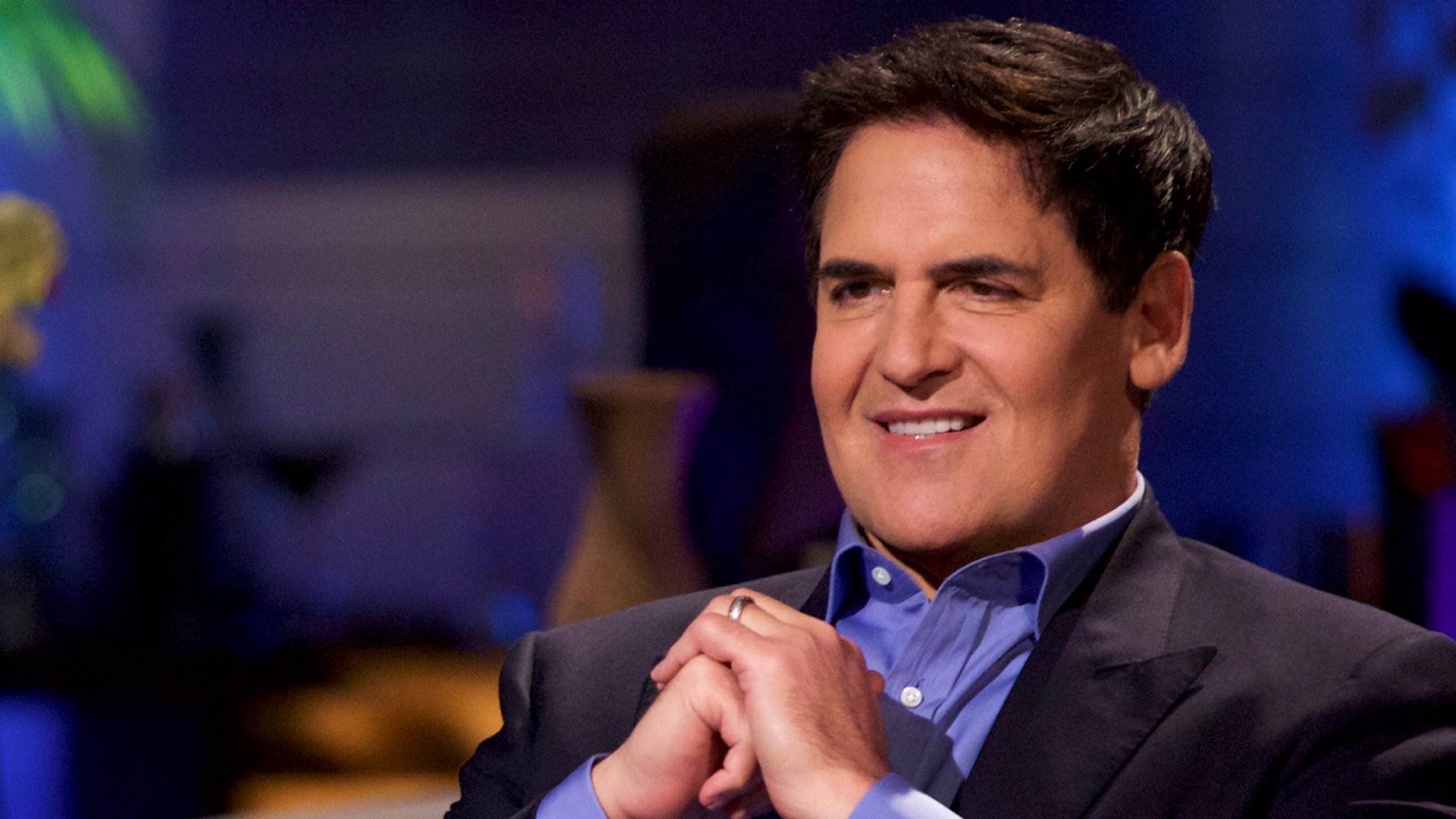
Marc Cuban, source: Inc. Magazine
Following the amazing success with Top Shot Moments, the NBA has established a blockchain advisory group to explore potential uses of the emerging technology.
The group includes billionaire Dallas Mavericks owner Mark Cuban, Washington Wizards owner Ted Leonsis and Brooklyn Nets owner Joseph Tsai and is tasked with determining how to leverage blockchain to benefit the NBA’s business.
JPMorgan posts 61 blockchain jobs

J.P. Morgan is one of the global leaders in financial services. S&P Global ranked JPMorgan Chase as the largest bank in the United States and the 5th largest bank in the world by total assets.
The bank has recently established a business unit solely focused on blockchain development, called Onyx, in October. Liink is J.P. Morgan’s peer-to-peer blockchain-based data network, operating under Onyx.
True to its commitment to digital currency and blockchain, the bank is now aiming to build its blockchain engineering team. The JPMorgan site is now displaying 61 open jobs for blockchain ranging from software engineers to a DevOps Engineering Lead (Vice President).
The majority of the job openings are in India, Singapore, the US and the UK.
Join the Conversation
We’d love to hear what you have to say.
Get in touch with us on our LinkedIn Page, Facebook Page, Twitter or TikTok.
BCG growth-share matrix for Amazon
BCG growth-share matrix is a business framework that helps companies analyze their business units (i.e. their product lines) or any other cash-generating entities by their degree of profitability.
To show how you can use the matrix for your business, let’s analyze e-commerce leader Amazon, specifically four of its products: Amazon AWS, Amazon Video, Amazon Live and Amazon Echo with Alexa.
Before placing each of these products in one of the four quadrants of the BCG growth-share matrix (i.e. cash cows, question marks, dogs and stars), we need to gather the latest information on market size, product market share and market growth rate.
AMAZON AWS
Amazon Web Services (AWS) is the company’s cloud platform, offering over 200 fully-featured services from data centres globally.
AWS offers reliable, scalable, and inexpensive cloud computing services.
AWS Market – Cloud computing services
The global cloud computing market size was valued at $405 billion in 2021 and is expected to expand at a Compound Annual Growth Rate (CAGR) of 20% from 2022 to 2029 (source).
The market is comprised of three services: IaaS (Infrastructure as a Service), PaaS (Platform as a Service), and SaaS (Software as a Service).
AWS is developed with a combination of infrastructure as a service (IaaS), platform as a service (PaaS) and packaged software as a service (SaaS) offerings.
In 2021, AWS brought $62 billion in revenue, up nearly 37% year-over-year (source). 13% of Amazon’s sales and a whopping 74% of its operating income were generated by AWS sales.
AWS Market share – 33%
AWS has 33% of the market, followed by Azure at 20%, Google at 7% with Alibaba Cloud close behind.
AWS market growth rate – 30%
According to the latest reports, the global cloud computing market is expected to grow by 20% annually.
Conclusion
With a 32% market share, growing nearly 30% year on year, Amazon AWS is a STAR.
AMAZON VIDEO
Amazon Prime Video is a video streaming service available for Amazon Prime members.
Amazon Video Market – The video streaming service market (SVOD)
According to Statista, revenue in the video streaming market (SVoD) is projected to reach $71 billion in 2021.
User penetration will be 14.3% in 2021 and is expected to hit 18.2% by 2025.
In 2021, there are 1 billion users of video streaming subscriptions.
Amazon Video Market share – 22%
As of January 2020, there are 150+ million Amazon Prime Video users. The service is available in over 200 countries internationally.
In 2018, Amazon’s Prime Video Channels Biz generated $1.7 billion, which was expected to reach $3.6 billion by 2020 (source).
According to Forbes, in 2020, due to people spending more time at home, Prime Video service emerged as another big player in the streaming wars climbing rapidly in the top 3 global video streaming service providers to a 22% market share. The company had announced plans to spend $7 billion on content last year.
Netflix, the leader of the market, jumped to over 200 million streaming subscribers in 2020 and unsurprisingly, announced a $16 billion budget for new content. Total Netflix 2020 revenue came to $25 billion, up from $20 billion in 2019.
Amazon Video market growth rate – 23%
Revenue for the global video streaming services market is expected to show an annual growth rate for the period 2021-2025 of 11%, resulting in a projected market volume of $108billion by 2025.
The latest reports submit that in 2020, Prime Video subscriptions accounted for 23% of SVOD subscriptions, a sharp increase from its previous 14% last quarter (source).
Conclusion
Amazon Video has been growing steadily over the past few years and in 2020 the number of subscribers received a boost. Currently the 2nd most popular video streaming service provider, Amazon Video has still a long way to go and a lot of money to invest. According to the BCG growth-share matrix, Amazon Video is a star.
AMAZON LIVE
Amazon Live is a live streaming service that allows sellers to “promote discovery” of their products by hosting their own livestreams for customers on Amazon.
According to data from Sensor Tower, Amazon Live was released in February 2019.
Amazon Live is the company’s second attempt at live-streaming. Back in March 2016, Amazon launched its first foray into live stream shopping, Style Code Live. Style Code Live was focused on fashion-related Amazon products.
Amazon Live – live commerce market
Live commerce is growing rapidly. It’s estimated to already be $60 billion annually. Last year over 430 million people, about 30% of China’s population, viewed livestreams, and in 2020, it’s projected to reach 560 million, or around 39%. Sales from live streams are expected to grow more than 100% in 2020 vs. 2019 (source).
Live-streaming is rapidly transforming into a standard feature for e-commerce. Taobao’s live commerce surged in 2019, achieving a growth rate for live-streaming-prompted-sales of over 150% for three consecutive years, making it the fastest growth model of e-commerce globally. In China, the latest reports show that the live commerce market has reached $66 billion in 2019 and is expected to double in 2020.
During last year’s Singles Day, Taobao saw an increase of more than 220% in the number of merchants participating in live streaming over the past 12 months. Gross merchandise value (GMV) sold during the 2020 Singles Day reached $74billion (source).
Amazon Live market share – N/A
Amazon Live is just starting out so I couldn’t find statistics related to its market share.
Amazon Live market growth rate – N/A
Sales from live streams are expected to grow globally more than 100% in 2020 vs. 2019 (source). Although live shopping has been reported to increase sales, Amazon hasn’t released any statistics on how many sellers use its Live platform yet. To be on the safe side, let’s assume the live platform to have a low market growth.
Conclusion
Live e-commerce is growing exponentially. Remember the internet boom in the early 1990s? This is the stage we are at with shopstreaming and China is the spearhead. With a low market share and low market growth, in a hyper-growth market, Amazon Live is a question mark type of product. With the right resources and strategy, Amazon Live could transform into a star. But if the market conditions are not assessed correctly, it could downgrade into a dog type of product.
AMAZON ECHO + ALEXA
The Amazon Echo with Alexa, the virtual assistant is a smart speaker.
In January 2019, Amazon’s devices team announced that they had sold over 100 million Alexa-enabled devices.
Amazon generated about $1.4 million in Alexa “skill” revenue in 2019 — about 25% of the forecasted $5.5 million. Despite its success with homeowners, Amazon Echo with Alexa is yet to prove a financial success.
Amazon Echo + Alexa – Smart speakers market
Amid the COVID-19 crisis, the global market for Smart Speaker was estimated at $2.7 billion in the year 2020. The market is projected to reach a revised size of $19 billion by 2027, growing at a CAGR of 32% over the analysis period 2020-2027 (source).
Amazon Echo + Alexa market share – 21,6%
Amazon was the leading vendor in the global smart speaker market, having a market share of %21.6% in the second quarter of 2020.
Google is Amazon’s closest competitor, with a share of 17.1% in the same quarter. Chinese vendors Baidu, Alibaba and Xiaomi have become strong players in recent quarters, thanks to growing demand in the Chinese domestic market (source).
Amazon Echo + Alexa market growth rate – 32%
The smart speaker market is growing at a CAGR of 32%.
Conclusion
In 2017, Amazon Alexa had a market share of almost 80%. Google began developing and investing in its own smart speaker and gnawing at Amazon’s lead. Currently with a shrinking 21,6% market share, negative market growth and underperforming revenue, in a growing market, Amazon Alexa is a dog type of product.
Join the Conversation
We’d love to hear what you have to say.
Get in touch with us on our LinkedIn Page, Facebook Page, Twitter or TikTok.
What is the McKinsey 7S framework for successful management
What is the McKinsey 7S model explained briefly?
The McKinsey 7S model is a business framework to address the essential role of coordination, rather than structure, in organizational effectiveness.
This business framework states that the organization is not the structure and is a model of organizational change.
Whenever organizations need to adapt to new business environments the hierarchy of the organization (who is tasked with what, who reports to whom, who needs approval from whom etc) is irrelevant.
The organization goes beyond its structure. It’s a complex ecosystem comprised of seven factors which interact with each other and influence an organization’s ability to change.
What are the 7S of McKinsey’s framework?
The seven factors of the McKinsey 7S framework are STYLE, SKILLS, SYSTEMS, STRUCTURE, STAFF, STRATEGY and SHARED VALUES.
For an organization to change successfully, it needs to approach every S factor.
The framework shows that every factor interacts with the other six. The organization cannot make significant progress towards change by focusing on one area and ignoring the rest. The organization must tackle its approach to change by moving into all seven S factors.
Let’s explain every S factor of the McKinsey model.
McKinsey 7S framework – Style
By style, the authors of the McKinsey 7S framework mean culture.
What is organizational culture and why is it essential to an organization’s success?
The culture of a company or organization is a set of shared beliefs, values and practices. The organization’s CEO, founder or top management are responsible for outlining the organization’s culture and hiring the right people that will maintain it.
For many organizations, culture drives success.
Neflix’s No rules policy is at the heart of its culture. The famous entertainment company nurtures employee freedom and encourages responsibility.
At UiPath, the efforts of top management are focused on providing employees with psychological safety beyond anything else.
At Amazon, employees are encouraged to think like an owner.
In every one of these organizations, success is synonymous with innovation and culture is the medium that facilitates innovation.
McKinsey 7S framework – Skills
Skills refers to organizational skills as well as individual skills.
What does your organization do best? What is your organization known for? What are its strengths? Is it creativity and design? Is it distribution or sales?
BMW is known for its innovative engineering and fast engines.
Coca-Cola has one of the most successful distribution systems in the world.
Louis Vuitton is renowned worldwide for its high-quality luxury handmade handbags.
The skills factor is also important to reveal skills gaps in the organization. With the business environment being disrupted by new technologies, organizations face increasing needs to fill skills gaps. They can either hire highly-specialized talent or upskill their current employees.
Another question that organizations must aks is do we need to improve hard skills or soft skills?
It’s an important question because the needs of an organization may shift every few years to follow changes taking place in our society. Read about the top 5 most in-demand soft skills in 2021.
Marketing is an industry where learning never stops. The professional growth and career advancement of a marketer now hinge on his or her desire and ability to learn new things. Read 4 skills that every successful marketer should acquire in 2021.
McKinsey 7S framework – Systems
By systems, the McKinsey framework means all the procedures, formal and informal, that make the organization go day by day.
How does the organization get things done?
Here are some of the main systems that an organization operates to achieve its goals:
- IT
- Financial
- Hiring
- Customer service
- Product development and delivery
- Information management
- Internal communication
- Planning
- Employee evaluation
There is a significant difference between how organizations were doing customer service in the 1980s and how it’s done today.
Organizations nowadays have a slew of digital tools they can use to solve the customer’s requests efficiently – Chatbots, Whatsapp, social channels etc.
McKinsey 7S framework – Structure
The structure factor of the McKinsey 7S framework refers to the way the organization is structured.
Is it centralized, decentralized or a hybrid?
Historically, the first organizations were centralized with one man, ie the founder or the CEO, taking every decision.
Apple under Steve Jobs is an example of a centralized organization where the founder made decisions regarding design, functionality, features etc.
The centralized organization can be very effective and ensures that the founder’s vision is carried out throughout the company and reflected in the product. But when the organization scales up, this type of organizational structure reveals its flaws. The organization is slow to make decisions and adapt to changing circumstances.
Starting with the 1950s, decentralization became the focus of organizations which had achieved a certain level of size and complexity.
Within these organizations, the number of employees had increased and subsequently the number of interactions required to make things work. The size and complexity of these organizations had become a burden and they were in danger of breaking down.
Decentralization was the solution. A decentralized organization is able to make decisions fast and adapt swiftly to its environment.
Other organizational structures are the line structure, the functional structure, the line-and-staff structure, the project-based structure, the matrix structure etc.
McKinsey 7S framework – Staff
Staff refers to the people in the organization and looks into the ways the organization nurtures and develops its employees.
How does the organization motivate its employees? What strategy does the organization employ to hire for diversity? Once diversity achieved, does the organization have an inclusion strategy?
Workforce diversity is a competitive advantage. A team which includes members of different generations, background cultures, interests and talents provides the organization with different insights and perspectives and drives creativity.
McKinsey 7S framework – Strategy
Strategy is defined as the actions a company plans to take to achieve its business objectives.
The plan outlines what (resources), how (specific tools, activities, platforms etc) and why (the reasons behind your choice of a specific resource or tool) the company will use to achieve its goals.
The strategy’s secondary goal is to define how the organization differentiates itself from the competition and create unique value. Learn how to create a strategic plan in 5 steps.
A successful organization must be able to change its strategy to match the current business environment. When organizations fail to see the need to change, they miss out on the opportunity to adapt and survive.
Nokia’s culture of status, shared fear and temporal myopia made the company vulnerable to competitive forces and prevented it to adapt its strategy (more on this in Why did Nokia fail?).
Microsoft, on the other hand, learned from Nokia’s mistakes (Microsoft acquired Nokia in 2014). When Satya Nadella became CEO, his main leadership challenge was to change the company’s culture. In his opinion, “The C in CEO stands for Culture”.
McKinsey 7S framework – Shared values
What is the organization trying to achieve? What is the organization’s social mission? How does the organization respond to the question Why?
In 2009, best-selling author Simon Sinek defined the concept of Why as the purpose, cause or belief that drives every one of us, leaders and employees alike.
Google’s mission is to organize the world’s information and make it universally accessible and useful.
TikTok’s mission is to inspire creativity and bring joy.
BRAND MINDS’ mission is to unite the business world by providing world-changers with the ultimate business experience.
Having a clear mission statement and delivering on it is paramount for a company’s reputation and bottom line. Consumers and employees expect organizations to stand for something. When they fail to deliver, organizations are met with protests and call-outs. For some organizations, change is now coming from employees putting pressure on the management, not the other way around.
Join the Conversation
We’d love to hear what you have to say.
Get in touch with us on our LinkedIn Page, Facebook Page, Twitter or TikTok.
Jeff Bezos is stepping down as Amazon CEO. What is his legacy?
In a letter published yesterday, Jeff Bezos announced he is stepping down as Amazon CEO later this year. Andy Jassy, Amazon’s head of cloud computing will be taking the helm.
Jeff Bezos founded the eCommerce retailer 27 years ago in a garage when it “was only an idea” and people were asking him “What’s the internet?”.
Leveraging the power of the internet and thanks to his vision on what makes a successful company, today Amazon is the world’s largest online retailer of consumer products and a leader in the cloud computing segment.
With a market value of 1.6 trillion dollars, Amazon is in the Top 5 big tech US companies and it doesn’t look like it’s going to slow down.
“Being the CEO of Amazon is a deep responsibility, and it’s consuming. When you have a responsibility like that, it’s hard to put attention on anything else”, he writes. In his new role as Executive Chair of the Amazon Board, Jeff Bezos will still watch closely over the company but will dedicate his time and energy to other Amazon initiatives such as the Day 1 Fund, the Bezos Earth Fund, Blue Origin, The Washington Post “and my other passions”.
As Jeff Bezos steps down as CEO of the world’s largest eCommerce retailer, let’s take a look at what he leaves behind, his legacy.
Jeff’s business strategy is his legacy.
Here are eight essential factors of Jeff’s successful business strategy for Amazon:
1. Move quickly to solidify and extend your current position
In 1997, with big tech companies like Microsoft and AOL expressing interest in online commerce, Bezos saw a window of opportunity.
“Our goal is to move quickly to solidify and extend our current position while we begin to pursue online commerce opportunities in other areas. We see substantial opportunity in the large markets we are targeting”, he writes in his 1997 shareholder letter. I remind you that, at the time, Amazon was still selling books.
2. Set out to delight your customers
Jeff believes complaining customers are a company’s most valuable resource for growth. They reveal blind spots that employees or managers could not otherwise identify giving the business the opportunity to improve and develop.
Amazon’s focus on customer obsession is one of its underlining factors for success.
3. Make bold investment decisions
At the heart of Amazon’s investments is the customer.
Every investment that Amazon makes is to further improve customer satisfaction and experience by developing systems, infrastructure and service.
4. Become aware of proxies
In his 2016 shareholder letter, Jeff talks about the danger of allowing proxies to gain power within the company.
Proxy is something or someone who acts as a substitute. This is when the process has become more important than the result and replaced it. It’s the process as a substitute for the outcome.
When someone in the company starts saying This is how we’ve always done it, it’s time for a change.
5. Your employees must think like an owner
Jeff acknowledged early on that hiring the right people was paramount if Amazon was to be successful and achieve its objectives. “Setting the bar high in our approach to hiring has been, and will continue to be, the single most important element of Amazon.com’s success.”
The retailer behemoth compensates its employees in Amazon stock than cash because becoming stockholders changes their mindset.
6. Embrace external trends
Businesses that adapt to the latest technological trends and customer behaviour changes evolve and survive. Businesses that resist change, don’t survive.
His advice to every company founder is to acknowledge powerful external trends like AI and machine learning and embrace them quickly.
7. Make high-quality decisions fast
Large organizations like Amazon have many things going for them with one downside: they are slow at making decisions.
Jeff didn’t allow this to happen to Amazon.
He created a system of making high-quality decisions fast which relies entirely on the Day 1 mindset. Day 1 companies are startups, nimble and agile, bursting with vitality. Day 2 companies are already heading for the end. Amazon is a Day 1 company.
8. Implement high standards
Amazon’s obsession with customer satisfaction has led to a number of outstanding product innovations (Alexa, AWS) and excellent customer experience (Amazon Go, 1-click purchases).
What does it take to achieve such results? Implementing high standards in the company.
At the core of Amazon’s supremacy is innovation. So it’s no surprise that Jeff Bezos ends his letter to the employees with an encouragement to continue down the path of innovation.
Keep inventing, and don’t despair when at first the idea looks crazy. Remember to wander. Let curiosity be your compass. It remains Day 1.
Jeff
Join the Conversation
We’d love to hear what you have to say.
Get in touch with us on our LinkedIn Page, Facebook Page, Twitter or TikTok.
How Amazon, Nike and UiPath drive innovation
Innovation is at the core of Amazon, UiPath and Nike. Curious to know how these global companies drive innovation? Keep reading!
Amazon – Innovating by focusing on customer needs like no other company in the world
On December 15, 2020, Amazon announced that Twitter has selected AWS to provide global cloud infrastructure to deliver Twitter timelines.
A day before, Amazon launched Alexa’s new Live Translation feature. This feature allows individuals speaking in two different languages to converse with each other, with Alexa acting as an interpreter and translating both sides of the conversation.
Earlier this month, on December 8, 2020, Amazon Web Services (AWS) and the BMW Group announced a comprehensive strategic collaboration to further accelerate the automaker’s pace of innovation by placing data and analytics at the center of its decision-making.
These are just a few of the innovations that Amazon releases on a monthly basis. Amazon began focusing on technology innovations in the late 1990s.
The company’s first major breakthrough was its recommendation algorithm, also named recommendation engine.
In 2003, Amazon published a research paper which described a new way of filtering, the Item-to-item Collaborative Filtering.
“At Amazon.com, we use recommendation algorithms to personalize the online store for each customer. The store radically changes based on customer interests, showing programming titles to a software engineer and baby toys to a new mother”, was said in the paper.
Today, Amazon’s machine learning-powered recommendation engine drives 35% of its sales according to a McKinsey report.
An online bookstore initially, Amazon has become rapidly aware of the necessity of becoming a tech company.
In 2019, the research and development expenses of Amazon were around $36 billion compared to $16.9 billion of Microsoft.
Amazon’s investment supports the company to achieve its vision of becoming “Earth’s most customer-centric company.”
Here is a list of the most important innovations developed by Amazon:
Amazon Go
Amazon Go is a chain of convenience stores in the United States, operated by Amazon. The stores are partially automated, with customers able to purchase products without being checked out by a cashier or using a self-checkout station. There are currently 27 Amazon Go stores.
Amazon fulfillment centers
In every fulfilment centre, computer vision systems analyze images to help Amazon staff keep track of everything. Based on data, AI solves a large combinatorial optimization problem and decides which orders to pick at the same time in order to get them in the same box. This way the system minimizes the distance the transport pods have to travel. AI optimization makes these decisions in real-time and with information that is constantly changing.
Amazon Prime Now
Amazon Prime Now is an app which allows users to order tens of thousands of products to their homes with 1-hour delivery and FREE 2-hour delivery.
Amazon Prime Air
Amazon Prime Air is a service that will deliver packages up to five pounds in 30 minutes or less using small drones.
AWS – Amazon Web Services (AWS) is the world’s most comprehensive and broadly adopted cloud platform, offering over 175 fully featured services from data centers globally. The platform is used by individuals, companies, and governments, on a metered pay-as-you-go basis.
Alexa
Alexa is a virtual assistant AI technology developed by Amazon in 2014 and first used in the Amazon Echo smart speakers.
Kindle
Kindle is a series of e-readers which enable users to browse, buy, download, and read e-books, newspapers, magazines and other digital media. The device was launched in 2007.
Style Snap
StyleSnap is the latest Amazon AI-powered feature which supports fashion-focused shoppers.
Show and Tell
Show and Tell allows the blind to identify grocery items by holding each item to the Echo Show camera and ask, “Alexa, what am I holding?”. The smart speaker identifies the item through advanced computer vision and machine learning technologies for object recognition.
UiPath – The path to innovation is paved with humility
UiPath is the world’s leading Robotic Process Automation vendor.
For the second consecutive year, UiPath has been placed highest in the Leaders’ quadrant for ability to execute by Gartner.
In July 2020, UiPath became the first European Cloud Decacorn with $10.2Bn valuation in a new funding round of $225M.
At UiPath, innovation comes from actively listening to and engaging with the company’s customers. “Solving real-world problems using artificial intelligence (AI)—and pairing AI with RPA—motivates every individual at UiPath.”
The company gathers feedback from many touchpoints, including preview programs, its customer advisory board, their 400k+ user community, meetups, and conferences.
UiPath’s purpose is to accelerate human achievement. The company’s core values are speed, immersion, boldness and humility.
UiPath top management believes that if their people are not happy, they have failed no matter how successful the company is. That’s why being a successful leader at UiPath means exercising humility and practising active listening. The employee who is provided with psychological safety is more likely to focus on achieving the company’s business goals.
Nike – Innovation through knowledge and insights
Nike is no longer just an athletic shoe manufacturer, it’s a technology company.
The brand’s mission is to expand human potential. And to achieve that, Nike creates new products through game-changing innovations.
Most innovations come from the brand’s own lab, the Nike Sport Research Lab which the company set up in 1980. The lab focuses on biomechanics, physiology, sensory/perception and data science.
Over the course of thirty years, Nike’s lab, employing more than 40 researchers has grown into a world-class research facility. Its function is to provide knowledge and insights and turn data into innovative products for athletes.
The Nike Flywire support system, Lunarlite foam cushioning, Hyperdunk basketball shoe are among the most famous.
The latest innovation is Nike Fit, a foot-scanning solution designed to find every person’s best fit. Nike Fit uses a proprietary combination of computer vision, data science, machine learning, artificial intelligence and recommendation algorithms to find your right fit.
A report from 2017 estimated that Nike has spent “~$2.5 billion on research and development in the last five years.”
Read BUSINESS reSOURCES: a PESTEL analysis of Nike
Join the Conversation
We’d love to hear what you have to say.
Get in touch with us on our LinkedIn Page, Facebook Page, Twitter or TikTok.
5 steps to create a strategic plan that will support your business vision
In this article:
What is strategic planning in business: definition of the strategic plan, who creates a strategic plan, the main goal of a strategic plan;
Strategic plan vs Business plan;
Benefits of strategic planning;
The strategic planning process: 5 steps to create a strategic plan that will support your business vision.
1. What is strategic planning in business?
Strategic planning is an organizational management activity. The company’s CEO and senior leadership team are tasked with creating a strategic plan, it’s one of their responsibilities.
The goal of a strategic plan is to provide you with a roadmap to align the organization’s functional activities to achieve set goals and determine the direction in which you want to take your business.
The plan outlines what (resources), how (specific tools, activities, platforms etc) and why (the reasons behind your choice of a specific resource or tool) the company will use to achieve its goals.
The main goal of your strategic plan is differentiation
The main goal of the strategic plan you create for your business is to define how your business differentiates itself from the competition.
What activities is your business performing that are different from the activities performed by your competitors?. Or what activities that are similar to your competitors’ you perform differently?
Harvard professor and author of Porter’s 5 Forces Michael Porter defines strategy as “performing different activities from others or performing similar activities in a different manner.”
Nikki Reed’s jewellery – a case study on business differentiation
Twilight series actress Nikki Reed designs beautiful jewellery. Her collections include 14-18 karat gold pieces. As opposed to other jewellery designers, her collections are made from e-waste.
Nikki’s business goal is to produce jewellery that is ethically made, sustainable and chemical-free. To achieve her goal, she partnered with computer technology company Dell.
According to the latest stats, it is estimated that our smartphones contain more than $60 million in gold and/or silver which are thrown away every year. Dell has developed a process for extracting gold from old computer motherboards that is 99% more environmentally friendly than extracting gold from the earth.
That’s how Nikki Reed differentiates her business from competitors: by using gold responsibly extracted from recovered technology to make beautiful jewellery. See her collections.
2. Strategic plan vs Business plan
A strategic plan is for established businesses looking to grow by providing them with focus, direction and action. Whereas a business plan is for businesses starting out and provides the entrepreneur with a structure for his ideas defining the business.
A strategic plan generally covers a period of 3 to 5+ years, whereas a business plan is normally no more than one year.
Discover more differences between a strategic plan and a business plan.
3. Benefits of strategic planning
No matter how much you wished your business had no competition on the market, your competitors are not going away just because you wish them to.
What you could do, after a thorough analysis of your business, the market and your competition is to devise a strategy that would help your business achieve its goals by doing things differently.
By having a strategic plan in place the top management conveys trust to the company’s employees.
A clear path to achieving set business goals means the team is more likely to enjoy an increased level of focus, determination and creativity.
Success is more easily achievable when everyone knows what to do and how to do it.
4. The strategic planning process
Before going into the strategic planning process, the CEO and top management have to be clear on the company’s vision, mission and organizational goals and objectives.
The CEO or founder is responsible for creating the vision and formulating the mission. The business vision states why you do it while the business mission states what your company does to achieve its vision.
The vision statement provides a snapshot of what the world would look like as a result of the company’s services. The mission statement is the roadmap for the company’s vision statement.
Let’s look at the vision and mission statements of a number of companies whose products and services you might use on a daily basis.
Vision – To provide access to the world’s information in one click.
Mission – Our mission is to organize the world’s information and make it universally accessible and useful.
AMAZON
Vision – We aim to be Earth’s most customer-centric company.
Mission – Our mission is to continually raise the bar of the customer experience by using the internet and technology to help consumers find, discover and buy anything, and empower businesses and content creators to maximize their success.
SALESFORCE
Vision – Salesforce is the world’s #1 customer relationship management (CRM) platform.
Mission – We bring companies and customers together. We help your marketing, sales, commerce, service and IT teams work as one from anywhere — so you can keep your customers happy everywhere.
Did you know? SalesForce has recently announced that it will acquire Slack for $27.7 billion.
TIKTOK
Vision – TikTok is the leading destination for short-form mobile video.
Mission – Our mission is to inspire creativity and bring joy.
5 steps to create a strategic plan that will support your business vision
A company’s vision and mission are not set in stone. Your business may transform as a result of technological developments or customer behaviour changes. For this reason, it is important to revisit the company’s vision and mission and amend them if necessary.
- Market analysis
- Development
- Implementation
- Review and update
- Evaluation and measurement
Step 1 – Market analysis
Before anything else, it is important to get updated on the current status of your business.
Perform a SWOT analysis to see if there are changes in your company’s strengths, weaknesses, opportunities and threats?
Are there new threats looming over the business ushered in by the pandemic?
Can you turn a new threat into an opportunity?
How is the pandemic affecting your bottom line?
Next, apply PORTER’s 5 Forces framework to your industry to evaluate how the pandemic is influencing the drivers of profitability and competition in your market. Get your team together and discuss what valuable insights you can take away from this analysis. How could these insights help you come up with a specific and unique way in which to delight your customers today?
PESTEL is another great tool that you can use to understand the impact of macro-environmental factors on your business. The PESTEL acronym stands for Political, Economical, Social, Technological, Environmental and Legal.
How are these factors that you cannot influence, affecting your business?
Check out a PESTEL analysis of Nike
Once you have drawn relevant insights from your company and business market analysis, you can move to step 2 of the strategic plan: development.
Step 2 – Development
Sit down together with your team and write the strategic plan.
Include the following:
- Company description
- Mission, vision and value statements
- Strengths, weaknesses, opportunities and threats
- Describe the current drivers of profitability and competition (PORTER’s 5 Forces)
- Describe how the macro-environmental factors impact your business (PESTEL)
- Prioritize your objectives
- Determine your strategic position (ie: at least one way in which your business will differentiate itself from the competition)
- Describe in great detail how you are going to leverage your newly developed strategy to achieve your business goals (means of communication, resources, budget etc)
- Include an execution timeline and how you are going to measure success
- Review and revise the plan.
Step 3 – Implementation
Now that you have the strategic plan on paper it’s time to execute it.
But before that, you need to communicate your plan to the employees that are going to implement it.
Choose the best way to do that. Is it a lengthy email? Or an all-hands meeting?
Prepare yourself to answer questions and convey your vision as clearly as possible.
You might also need to provide inspiration and motivation.
Step 4 – Review and Update
Determine when to review the strategic plan over the course of the implementation and go back to the plan to update it if necessary: 3 months? 6 months?
Step 5 – Evaluation and measurement
Once the strategic plan has been executed, it’s time for evaluation and measurement.
Extract the results and measure them against your set projections.
Calculate the KPIs and ROI.
Did the strategic plan help your business to achieve its set objectives?
Join the Conversation
We’d love to hear what you have to say.
Get in touch with us on our LinkedIn Page, Facebook Page, Twitter or TikTok.
Top 7 biggest tech acquisitions of 2020
(UPDATED) What are the top 7 biggest tech acquisitions of 2020?
1. Oracle to take a 12.5% stake in TikTok Global
TikTok became available in the American market in 2018 after merging with another social media service Musical.ly.
Within two years, TikTok US has increased its monthly user base to 100 million, up 800%.
According to SensorTower, TikTok was the most downloaded app in 2020 with 82 million downloads globally.
Was TikTok’s global surge in downloads a result of Donald Trump’s threat to ban the US operation of the Chinese social app? Most likely.
Was the pandemic lockdown a contributing factor? Definitely yes.
In September 2020, Oracle announced that it was chosen to become TikTok’s secure cloud technology provider.
The company’s press release also reports that the decision was heavily influenced by Zoom moving a large portion of its video conferencing capacity to the Oracle Public Cloud.
According to Oracle Chief Technology Officer Larry Ellison, the cloud infrastructure is “much faster, more reliable, and more secure than the first generation technology currently offered by all the other major cloud providers”.
As part of the agreement, Oracle will become a minority investor in TikTok Global with a 12.5% stake in the company. How much is that worth? Well, it was estimated that ByteDance, TikTok’s parent company is valued at $100 billion and that TikTok’s US operations account for about 40% of ByteDance’s valuation, or about $40 billion. This means that Oracle’s stake is worth $5 billion.
However, the agreement is yet to be finalized with the American government granting TikTok an extension of its forced sale deadline until December 4, 2020.
2. Salesforce to acquire Slack for $27.7 billion
Salesforce is the top CRM providers worldwide empowering companies of every size and industry to digitally transform and create a 360° view of their customers. It is one of the fastest-growing enterprise software companies of all time with over 150,000 customers ranging from small businesses to FORTUNE 500 companies.
In 2019, Salesforce increased its market share to 18% followed at a distance by its competitors SAP, Oracle, Microsoft and Adobe.
In December 2020, Salesforce announced that the CRM provider has entered into a definitive agreement with Slack under which it will acquire the latter for $27.7 billion. Slack is one of the most innovative enterprise communications platforms. You can learn more about its growth story here.
This is a match made in heaven. Together, Salesforce and Slack will shape the future of enterprise software and transform the way everyone works in the all-digital, work-from-anywhere world. I’m thrilled to welcome Slack to the Salesforce Ohana once the transaction closes.
Marc Benioff, Salesforce CEO
3. Microsoft to acquire games developer ZeniMax Media for $7.5 billion in cash
Two years ago, Microsoft acquired seven games developer studios.
Today the market has grown to 3 billion gamers from 1 billion in 2018 and is expected to bring more than $200 billion in annual revenue in 2021. The gaming industry is one of the fastest-growing industries worldwide registering a CAGR of 9.17% over the forecast period (2020 – 2025).
With the acquisition of ZeniMax Media, the parent company of Bethesda Softworks, one of the largest, privately-held game developers and publishers in the world, Microsoft consolidates its foothold in the gaming industry. Under the terms of the agreement, Microsoft will acquire ZeniMax Media for $7.5 billion in cash.
ZeniMax Media are the creators of critically acclaimed and best-selling gaming franchises including The Elder Scrolls and Fallout among many others.
With unique investments in content, community, and the cloud, Microsoft’s gaming strategy differs from others by empowering people to play the games they want, with the people they want, anywhere they want. Games are the primary growth engine in gaming, and games are fueling new cloud-gaming services like Xbox Game Pass, which has reached a new milestone of over 15 million subscribers. With the addition of Bethesda, Microsoft will grow from 15 to 23 creative studio teams and will be adding Bethesda’s iconic franchises to Xbox Game Pass.
Microsoft Press Release
4. Adobe acquires work management platform for marketers Workfront for $1.5 billion
In November 2020, Adobe announced it has entered into a definitive agreement to bring Workfront, the leading work management platform for marketers, to Adobe Experience Cloud for $1.5 billion.
Founded thirty-eight years ago, Adobe continues to deliver award-winning software and technologies that have redefined and advanced business and personal communications.
Adobe Illustrator® and Adobe Photoshop® are groundbreaking software used by more than 90% of creative professionals worldwide for digital image editing and creation.
Adobe Experience Cloud is the most comprehensive solution for content and commerce, customer journey management, and customer data and insights, all built on an open platform, enabling businesses of every size across every industry to deliver exceptional customer experiences at scale.
With the acquisition of Workfront, Adobe makes the digital transformation easier for its customers.
Workfront has more than 3,000 customers and 1 million users and deep leadership in orchestrating marketing workflows. Workfront’s platform is agile and uniquely architected for the enterprise, with extensive integration capabilities that can be easily configured to meet the varied needs of companies of all sizes.
Together, Adobe and Workfront will provide our customers access to a single system to support planning, collaboration and governance that will unlock organizational productivity. Now marketers will not only create and deliver the best customer experiences but also efficiently and seamlessly manage the workflows that bring these experiences to life.
Adobe press release
5. Amazon to acquire self-driving tech startup Zoox for an estimated $1.2 billion
With a market capitalization of $1.7 trillion, Amazon is the third most valuable tech company in the world following Microsoft and Apple.
In June 2020, Amazon has signed an agreement to acquire Zoox, a self-driving tech startup designing autonomous technology from the ground up with passengers front-of-mind.
Amazon’s support will get the startup closer to its mission of delivering safe, clean, and enjoyable transportation to the world. Founded in 2014, Zoox’s tightly integrated features are designed to provide a revolutionary passenger experience. The startup has raised $955 million in venture-backed funding.
Amazon hasn’t disclosed the purchasing value of the agreement but industry experts estimate it is a little over $1.2 billion.
What are Amazon’s plans for Zoox?
Some experts say the company will more likely integrate Zoox’s technology into its distribution network than building a fleet of autonomous driving cars. This might happen in the near future.
For now, Zoox is sticking with its mission and is preparing to unveil its ride-hailing vehicle on December 14 under the tagline The future is for riders, not drivers.
6. Facebook to acquire customer-focused platform Kustomer for a reported $1 billion
In November 2020, Facebook announced that it reached an agreement to acquire Kustomer, a top-rated CRM that enables businesses to effectively manage all customer interactions across channels.
The goal of the platform with over 2.7 billion monthly active users is “to give businesses access to best-in-class tools that deliver excellent service and support.”
Facebook reports that more than 175 million people contact businesses via WhatsApp every day. Kustomer helps businesses optimize their time and quality of interactions with customers by bringing customer conversations from various channels together into a single-screen view.
Facebook plans to support Kustomer’s operations by providing the resources it needs to scale its business, improve and innovate its product offering, and delight its customers. That way, more people will benefit from customer service that is faster, richer and available whenever and however they need it, whether it’s phone, email, web chat or messaging.
Facebook press release
7. Cisco to acquire audience interaction company Slido for an undisclosed amount
In December 2020, Cisco announced its intent to acquire privately-held Slido, a technology company that provides a best-in-class audience interaction platform.
Cisco’s acquisition is a strategical business decision which allows the company to stay competitive with Zoom. Webex, Cisco’s video conferencing solution had 600 million participants in October 2020.
Slido developed a Q&A and polling platform designed to bridge the gap between speakers and their audiences. The company’s platform provides for its 7 million participants monthly a web-based application to actively engage people and get real-time feedback before, during, and after events and meetings.
With Slido’s technology, Cisco will integrate even more insights into the Webex platform to help everyone work smarter and be more productive whenever and wherever work happens. We are going to enable companies around the world that have traditionally relied on in-person events like townhalls, all-hands meetings and major user conferences to make sure everyone is engaged and included.
Cisco press release
Jeff Bezos: 8 business lessons from his letters to shareholders
According to recent industry figures, Amazon is the leading eCommerce retailer in the United States with 38,7% share of retail eCommerce sales (source).
Here are the latest Amazon statistics:
- $280.5 billion in net sales
- $11.59 billion in net income
- The most popular product categories: Electronics
- Number of paying Amazon Prime members worldwide: 150 million
- Share of US Amazon customers who are Amazon Prime members: 65%
- Unique monthly US visitors to Amazon sites: 208 million
- Share of direct traffic to Amazon.com: 56.47%
- US Amazon Prime Day conversion rate: 13.5%
- Average annual spending of Amazon Prime members: $1,400
- The most important reason for US shoppers to shop on Amazon: fast, free shipping
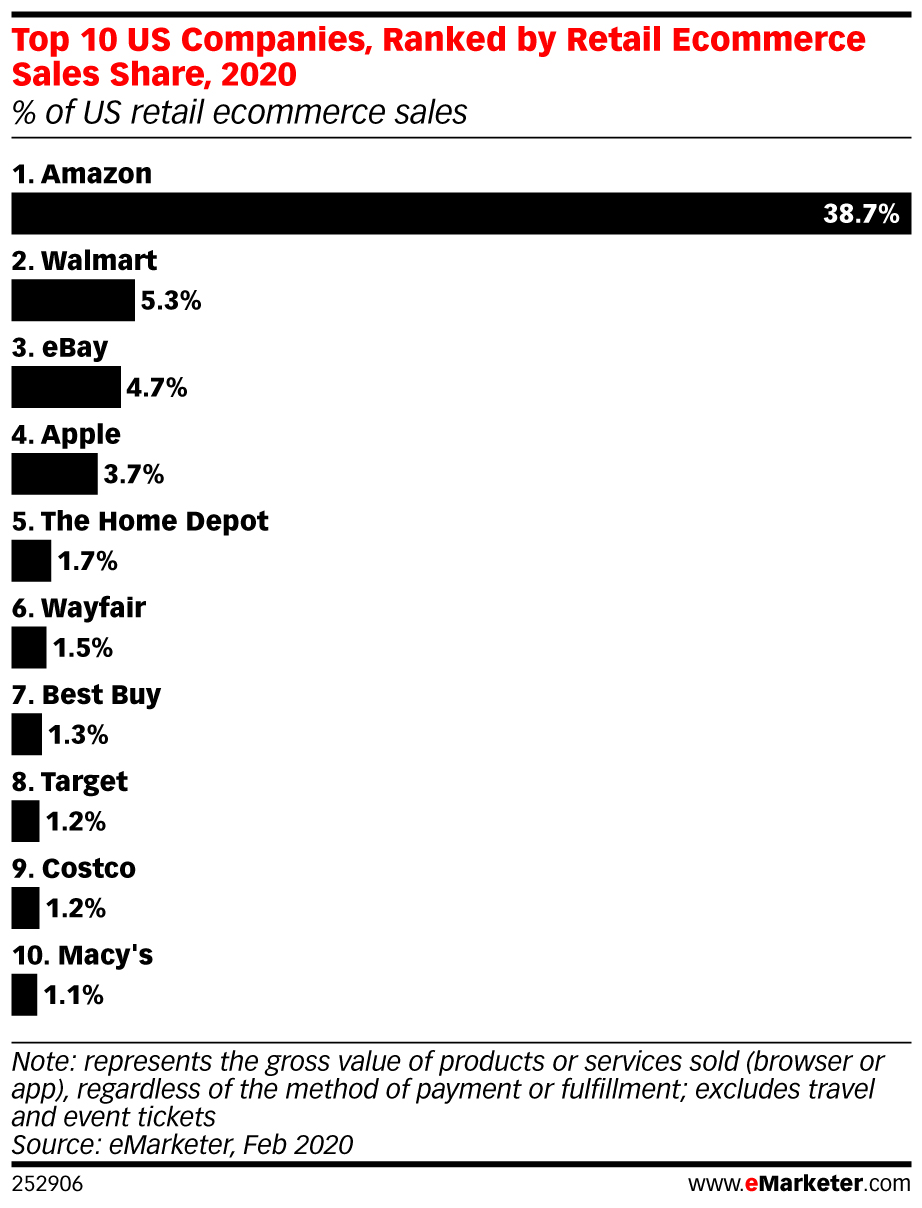
Amazon is #1 in the U.S. Let’s zoom out and take a global approach.
Is the giant retailer maintaining its top place when compared to other eCommerce retailers?
As you can see below, the answer is yes.
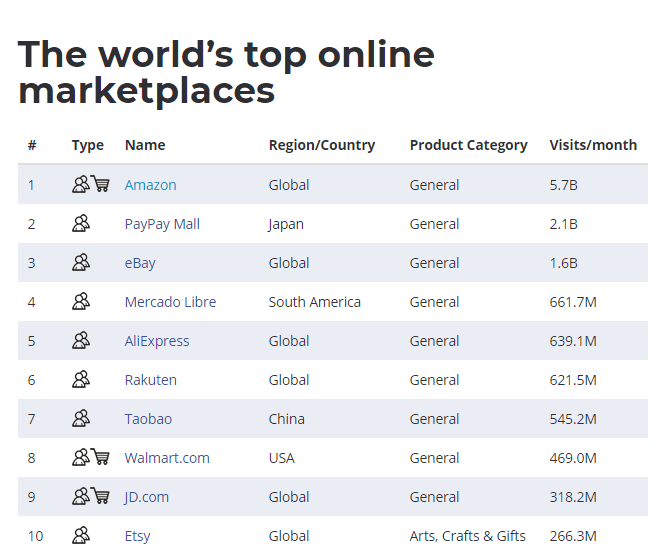
image source: webretailer.com
Amazon.com receives twice the monthly number of visitors as #2, the Japanese retailer PayPay Mall.
If the eCommerce retail industry were a marathon, Amazon would be the front runner, leading the other runners and winning by a landslide.
What makes Amazon so successful and powerful?
What drives this marathon runner to push harder year after year?
How is Jeff Bezos coaching the Amazon collective?
For the purpose of this article, I have analysed Jeff Bezos’ annual letters to shareholders from 2016, 2017, 2018 and 2019. As any Jeff Bezos fan knows, each of his letters ends with a copy of his famous 1997 letter so I have included it in my analysis.
Jeff Bezos: 8 business lessons from his annual letters to shareholders
1. Move quickly to solidify and extend your current position
At the end of 1997, in just three years since starting the company, Amazon.com’ revenue had increased by 838%, selling to more than 1.5 million customers while extending its market leadership in an increasingly aggressive competitive environment (source).
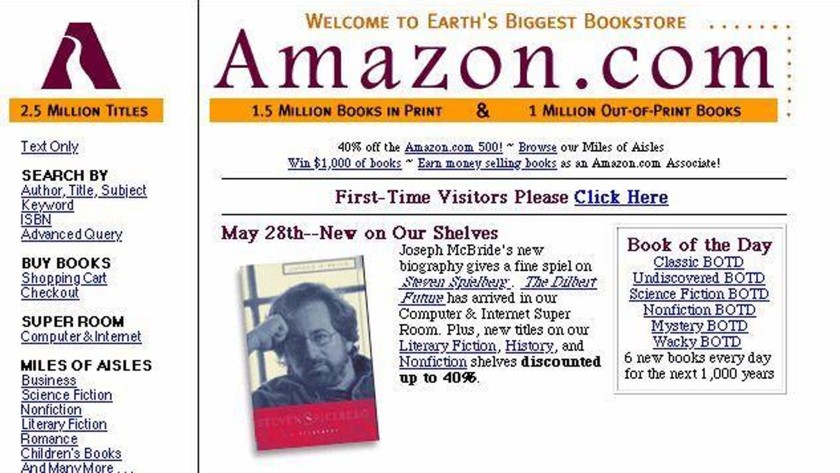
image source: latimes.com
1997 is the year Amazon filed to go public and was preparing to compete with big tech companies AOL and Microsoft which had announced their intention to derive a substantial portion of their revenues from online commerce.
I remind you that Amazon was still selling books at that time.
But that didn’t discourage Bezos who had a strong belief in the online opportunity as expressed in his 1997 letter:
We have a window of opportunity as larger players marshal the resources to pursue the online opportunity and as customers, new to purchasing online, are receptive to forming new relationships. The competitive landscape has continued to evolve at a fast pace. Many large players have moved online with credible offerings and have devoted substantial energy and resources to building awareness, traffic, and sales. Our goal is to move quickly to solidify and extend our current position while we begin to pursue the online commerce opportunities in other areas. We see substantial opportunity in the large markets we are targeting.
2. Set out to delight your customers
After reading Jeff’s letters, if I were to choose only one factor responsible for Amazon’s success it would be his focus on customers.
Complaining customers are a company’s most valuable resource for growth. They reveal blind spots that employees or managers could not otherwise identify giving the business the opportunity to improve and develop.
In his 2016 letter, Jeff says “customers are always beautifully, wonderfully dissatisfied, even when they report being happy and business is great.” In his 2018 letter, he defines them as “divinely discontent”.

image source: blog.aboutamazon.com
Achieving the goal of delighting customers means developing a powerful system built on true customer obsession.
So here’s the Amazon customer-focused trifecta:
- Listen to your customers and use this data to offer them something they simply could not get any other way
- Improving the shopping experience never ends so pursue it with tenacity and persistence
- Invent on behalf of your customers. Your customers will always want something better and it’s up to you to figure out what exactly it is they expect because, and here’s your challenge, they don’t know what to ask for.
We must invent on their behalf. We have to tap into our own inner imagination about what’s possible.
Jeff Bezos
That’s how AWS, one of Amazon’s most successful services came to be. No customer specifically asked for it and yet that’s what they needed. In 2019, AWS generated $10.2 billion in net sales, up 33% from last year.
Remarkable customer experience starts with heart, intuition, curiosity, play, guts, taste. You won’t find any of it in a survey.
Jeff Bezos
3. Make bold investment decisions
In his 1997 letter, Jeff talks about investments and the criteria underlining his investment decisions.
At the heart of Amazon’s investments is the customer. Every investment that Amazon makes is to further improve customer satisfaction and experience by developing systems, infrastructure and service.
Is the investment going to help the company come closer to its goal of achieving market leadership? Is the investment going to support the company achieve its long-term business objectives? If the answer is yes, then the investment gets the green light.
Always measure the effectiveness of your investments. Establish a set of KPIs to measure the results of your investments, discard the ones that don’t perform as expected and double down on the investments that work. Learn from both your failures and your successes.
If you see a sufficient probability of gaining market leadership advantages, go for it and be bold. There’s no need to start small, go bold!
4. Become aware of proxies
What is a proxy? Proxy is something or someone who acts as a substitute. In his 2016 letter, Jeff talks about the danger of allowing proxies to gain power within the company.
Have you ever heard someone say when referring to a bad outcome Well, we followed the process? That is when the process has become more important than the result and replaced it. It’s the process as a substitute for the outcome.
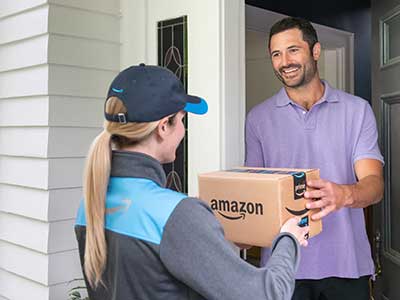
image source: amazon.com
This is a dangerous place for a company and could contribute to its downfall. Jeff’s advice is to become aware of any proxies influencing your business outcomes and eliminate them. Don’t allow market research and customer surveys to become proxies for your customers.
Good inventors and designers deeply understand their customer. They spend tremendous energy developing that intuition. They study and understand many anecdotes rather than only the averages you’ll find on surveys. They live with the design.
Jeff Bezos
5. Your employees must think like an owner
Jeff acknowledged early on that hiring the right people was paramount if Amazon was to be successful and achieve its objectives. “Setting the bar high in our approach to hiring has been, and will continue to be, the single most important element of Amazon.com’s success.”
Amazonians are committed to the company’s core values and goals. They are passionate about working to build something important, something that matters to their customers, something that they can all tell their grandchildren about. Jeff and his hiring team focus on attracting and retaining versatile and talented employees.
“When I interview people I tell them, You can work long, hard, or smart, but at Amazon.com you can’t choose two out of three”, Jeff said in his 1997 letter.

image source: amazon.com
How is Amazon motivating its valuable employees?
The company provides them with two options to choose from: receive compensation in Amazon stock or cash. The retailer would rather compensate its employees in Amazon stock than cash because becoming stockholders changes their mindset. Jeff expects employees to think and act like an owner. To achieve this, employees must actually be owners.
How do you support your employees to take ownership of their work? Do you believe employees thinking and acting like owners makes a difference in the quality of their work?
6. Embrace external trends
Today the business environment is shaped by a wide variety of external factors ranging from technology, online and digital to cultural shifts, changes in customer behaviour etc. Businesses that have adapted to these trends and transformed, as a result, survived. Businesses that have resisted change, didn’t.
Jeff talks about external trends and why businesses should embrace them in his 2016 letter. His advice to every company founder is to acknowledge powerful external trends and embrace them quickly.
Depending on the size of your organization, achieving this could be easy or difficult. It’s somewhat easier for a startup to embrace trends than for a large organization. That’s why it’s imperative for large companies to become agile.
When talking about external trends, Jeff is referring to machine learning and AI.
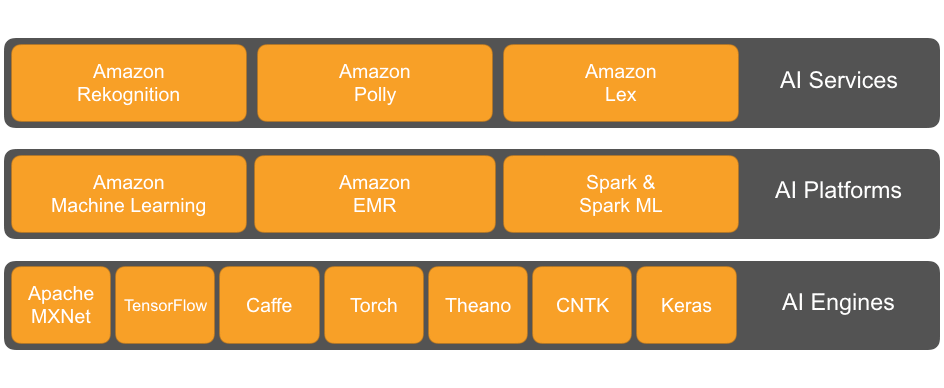
image source: aws.amazon.com
Amazon.com has been working on developing its own machine learning-powered recommendation algorithm since the late 1990s.
In 2003, the development team at Amazon published a paper describing a new recommendation algorithm. The recommendation algorithm they created was called the item-to-item collaborative filter and allowed the online store to radically change for each customer based on their interests.
A 2013 McKinsey article reported that Amazon’s machine learning engine was responsible for 35% of its online sales. I’m sure this number is higher today.
Jeff points out that machine learning drives Amazon’s algorithms for demand forecasting, product search ranking, product and deals recommendations, merchandising placements, fraud detection, translations.
But much of the impact of machine learning is less visible but equally important. Machine learning and AI have a prominent role in the company’s future.
7. Make high-quality decisions fast
Amazon is leading the global eCommerce landscape falling back on 26 years of experience in the industry. It’s one of the big five tech companies, FAAMG—Facebook, Amazon, Apple, Microsoft, and Google and the largest employer among them, with 840,000 employees.
Large organizations have many things going for them (attracting talent, high-value wages, global development, technology advancements etc) with one downside: they are slow at making decisions.
Jeff calls these established large organizations Day 2 companies. Day 1 companies are startups, nimble and agile, bursting with vitality. Day 2 companies are already heading for the end.
Day 2 is stasis. Followed by irrelevance. Followed by excruciating, painful decline. Followed by death. And that is why it is always Day 1.
Jeff Bezos
Twenty-six-year-old Amazon is technically a Day 2 company but with a Day 1 mindset. It’s what allows the giant retailer to keep the energy and dynamism of a lean startup while being #1 in the global eCommerce industry.
How do you make high-quality decisions fast?
Jeff gives the following pointers in this regard:
- Never use a one-size-fits-all decision-making process;
- Make decisions with around 70% of the information you wish you had. If you wait for 90%, in most cases, you’re probably being slow;
- Be good at quickly recognizing and correcting bad decisions. Being wrong may be less costly than you think, whereas being slow is going to be expensive for sure;
- Recognize true misalignment issues early and escalate them immediately;
- Use the phrase “disagree and commit”. If you have a conviction on a particular direction even though there’s no consensus, ask everyone else to gamble with you on it and you’ll probably get a quick yes.
Choose to have the scope and capabilities of a large company and the spirit and heart of a small one.
Jeff Bezos
8. Implement high standards
Staying ahead of the ever-rising customer expectations is one of Amazon’s objectives.
The giant retailer’s obsession with customer satisfaction has led to a number of product innovations (Alexa, AWS) and excellent customer experience (Amazon Go, the no checkout lines physical store, Prime Air, Amazon’s 30-minute delivery service via drones, one-click purchases).
What does it take to achieve such results?
A high-standard mindset.
Here’s what Jeff says about implementing high standards in your company:
- Expose your people to high standards. High standards are teachable and contagious;
- Articulate a few core principles of high standards which helps accelerate the rate of learning;
- Teach high standards in every arena of interest. High standards are domain-specific;
- Recognize the standard and have realistic expectations on scope. To achieve high standards yourself or as part of a team, you need to form and proactively communicate realistic beliefs about how hard something is going to be.
What are the benefits of high standards?
Building better products and services for customers, recruiting and retaining talent and teaching employees how to be professional starting with doing the most invisible work.
People have a voracious appetite for a better way, and yesterday’s ‘wow’ quickly becomes today’s ‘ordinary’.
Jeff Bezos
Join the Conversation
We’d love to hear what you have to say.
Get in touch with us on our LinkedIn Group, Facebook Group or Twitter.
Is John Lewis’ Christmas Advert the best advert of 2019?
It’s not Christmas until you’re holding back the tears while watching the John Lewis advert. Enthusiasts can relax now: John Lewis’ 2019 Christmas advert is out. But is it the best? I believe this year, the competition is giving John Lewis a run for their money.
In this article, I talk about the adverts released by Aldi UK, Sainsbury’s, Amazon, Walkers Crisps, Argos and, of course, John Lewis & Partners and a surprise I came across while doing research. I also invite you to share your top Christmas Adverts of 2019 in comments.
Is John Lewis’ 2019 Christmas Advert the best?
Let’s see!
Aldi UK Christmas Advert 2019
The discount chain introduced Kevin the carrot as the star of their Christmas Adverts back in 2016. Kevin’s fame has grown steadily ever since with Aldi turning him and his family into a soft toy.
Last year, when the toy went on sale, it was the subject of a buying frenzy which the stores have never anticipated. The stores’ supplies of the beloved character had quickly run out and people were not happy.
In last year’s advert, Kevin rescues his wife and children from a naughty parsnip. In this year’s story, he is the one in need of rescuing.
We see him tied up to a grater and threatened by an angry mob lead by Russel, the sprout. Russell is channelling Tommy Shelby, the main character in the Peaky Blinders TV series. The Hollywoodian source of inspiration doesn’t stop here. Upon being rescued by a tomato, Kevin breaks into singing and dancing as the Greatest Showman …aaaa, carrot.
Walkers Crisps Christmas Advert 2019
Nine years ago, Mariah Carey released her single All I want for Christmas.
Soon enough, the song became her biggest international success and the 11th best selling single of all time with 16 million copies sold.
Apparently, the world has not had enough of Mariah and her Christmas song.
Watch Mariah Carey win an argument over crisps by leveraging her superpower (if you don’t know what her superpower is, I’ll give you a hint: the Bottlecap Challenge).
Amazon Christmas Advert 2019
Amazon’s Christmas adverts of the past few years follow the same recipe: showing the journey of the Amazon delivery boxes and how they enrich everyone’s lives while singing a well-known feel-good song.
In last year’s ad, we see amazement at Amazon’s latest innovations: Alexa turning the Christmas lights on and the yellow robots doing twirls.
This year, it’s about love.
Love at first sight on the train, the joy of seeing your childhood friend and singing to your favourite song even if your voice is off-key, love shared by family members and same-sex lovers.
And now it’s time to share with you the surprise I was talking about earlier.
As I was doing my research, a question popped into my head: has Amazon always had singing Christmas adverts?
While I was ploughing through YouTube for older adverts, this came up:
It certainly answers my question. Amazon’s story-on-music recipe goes waaaay way back. If I’m not mistaken, it is part of Amazon’s brand.
I think what we are seeing above is a compilation of Amazon Christmas TV ads. The video was uploaded on YouTube in 2009, but the ads are definitely from an earlier period, maybe the 1990s.
Did you think Mary Poppin’s supercalifragilisticexpialidocious was difficult to remember?
Try Amazon’s EMAHTSKCBLVDT!
John Lewis & Partners and Waitrose & Partners Christmas Advert 2019
Last year, the retailer’s ad called The Boy and The Piano, inspired by Elton John’s life story earned over 14 million views.
Will this year’s ad raise to meet the audience’s high expectation? We’ll see.
It’s worth noting that seven hours after the video was published, there were over 1 million views and at the time of this article, it’s well over 8 million views.
Their story this year is about the friendship between a girl and a dragon named Excitable Edgar who ruins the festive experience for everyone in the village by being, well, a fire-breathing dragon.
We all have our own quirks and sometimes we may come off to others as strange. But each of us has its own place in the world. All we have to do is find it. Or have a friend to help us out.
It’s a great story but some say it strikes a remarkable resemblance to Franklin’s Flying Bookshop, a children’s book published in September 2017 by Jen Campbell in which a green dragon also alienated from the community he lives in, befriends a little girl with ginger hair.
This isn’t the first time the creative team behind John Lewis’ Christmas Adverts has been accused of drawing inspiration from other sources but failing to give credit. The 2017 Christmas Advert with Moz the blue monster has also received plagiarism accusations from Chris Riddell, author of Mr Underbed, a picture book about a friendly blue monster living under the bed of a little boy.
Responding to each claim, a spokesman for John Lewis said although monsters living under children’s beds and friendly dragons are very common, both stories are original stories developed by the creative agency.
Sainsbury’s Christmas Advert 2019
If Aldi’s advert is set in 1919, Sainsbury’s story is set in 1869, the year when John Sainsbury and his wife Mary Ann opened their first shop in London.
With this ad, the UK’s second oldest food retailer celebrates 150 years of history and claims to tell the real story of Nicholas the Sweep.
The advert tells the age-old story of the good versus the bad where the bad man gets a piece of coal and the orphans at the children’s home are each gifted an orange.
The magic is performed by Nick with a little help from Mrs Sainsbury who saves him from a gruesome death.
I only wish she had taught them how to eat an orange…
Argos Christmas Advert 2019
My favourite Christmas Advert of 2019 is not John Lewis’ Excitable Edgar; it’s Argos’ Book of Dreams. Argos is one of the UK’s leading digital retailers and was acquired in 2016 by Sainsbury’s.
The story created by Argos for their Christmas Advert is not about a singing vegetable or a magical dragon; it’s not a fairytale of good versus evil.
It’s the powerful story of how children discover their talents when parents encourage and support them.
It’s about building the strongest bond between parents and their children by giving them wings to fly and become the best they can be.
This type of story is timeless.
And watching this father and daughter duo play the drums gives me pure joy and happiness.
What is your favourite Christmas Advert?
Share in the comments!
Join the Conversation
We’d love to hear what you have to say.
Get in touch with us on our LinkedIn Group, Facebook Group or Twitter.
Amazon’s CTO & VP Werner Vogels will be speaking at BRAND MINDS 2020
We are excited to announce the latest speaker to join our BRAND MINDS 2020 lineup: Amazon’s CTO & VP Werner Vogels.
Last year, Amazon reached a market capitalization of $1 trillion (just behind Apple) and its net worth is estimated at $160 billion.
One of the factors which contributed to Amazon’s success is having Werner Vogels at the helm of technology, steering the company into the future.
Vogels’ vision and leadership have lead to the creation of one of Amazon’s highly successful services, the AWS.
With his extensive experience leading one of the most innovative tech companies in the world as its CTO&VP, Werner Vogels will be speaking at BRAND MINDS 2020 about Innovation at scale at Amazon.com
Let’s find out more about Werner Vogels.
Godfather of the Cloud
Vogels is was one of the architects behind Amazon’s approach to cloud computing, AWS (Amazon Web Services).
AWS is one of the world’s most comprehensive and broadly adopted cloud platform, offering over 165 fully-featured services from data centres globally.
Millions of customers —including the fastest-growing startups (Airbnb, Lyft etc), largest enterprises (Oracle, Siemens, Engie, Hilton, British Petroleum, Shell etc), and leading government agencies (the Smithsonian, Minnesota IT Services, City of Iowa City etc) —trust AWS to power their infrastructure, become more agile, and lower costs.

Image source: Werner Voges / sprout.nl
Named in the Top 10 Cloud Computing Leader list in 2010, 2011, and 2012
For three years in a row, Werner Vogels was included by TechTarget in its Top Cloud Computing Leader lists.
He earned Information Week’s 2008 CIO/CTO of the Year award and ReadWriteWeb’s “Cloud’s Most Influential Executive.
He also ranked #1 in Wired’s 2012 Top 10 Cloud Influencers, Thought Leaders.
I am an engineer, architect, scientist, programmer, troublemaker, executive, revisionist, investor, mentor, advisor, analyst, academic, sales guy, entrepreneur, data analyst, system administrator, product owner, evangelist, debater, father, musician and biker. And I probably forgot a few.
Werner Vogels
Doctor in Computer Science – One of the World’s Top Experts on Ultra-Scalable Systems
Dr Vogels studied computer science at The Hague University of Applied Sciences and received a PhD in computer science from the Vrije Universiteit Amsterdam, Netherlands. He is celebrated as one of the world’s top experts on ultra-scalable systems.
Dr Vogels joined Amazon in 2004 from Cornell University where he was a research scientist at the Computer Science Department.
From 1994 until 2004, he mainly conducted research in scalable reliable enterprise systems.
He is the author of many conference and journal articles, mainly on distributed systems technologies for enterprise computing systems.
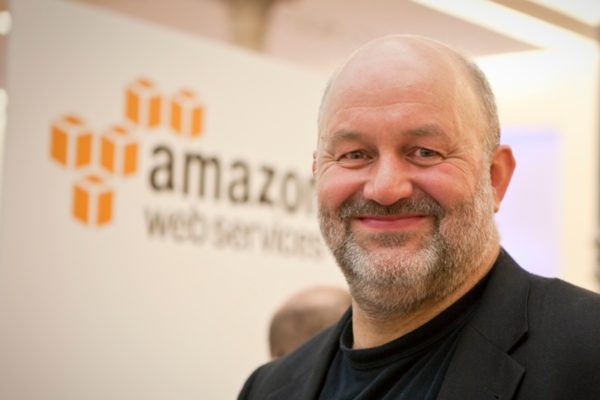
Was appointed VP&CTO at Amazon six months after he was hired
Prior to coming to Amazon, Werner was invited to give a talk on distributed systems for the company’s employees. His first thought was What do they need distributed systems? They sell books online!
After seeing what the Amazonians are working with, he realized Amazon was not an online bookseller, but a tech company by every definition and one that was actually 5-10 ahead of its time.
When Jeff Bezos offered Werner a job with Amazon, he was more than thrilled to accept it. Six months later he was appointed Vice President & Chief Technology Officer at Amazon.
One of the reasons for hiring Werner was to insert academic rigour into the way the company wanted to approach scaling.
At that time, in the early 2000s, Amazon had become really good at scaling but was struggling to overcome their latest challenge which was to do orders of magnitude.
Amazon asked Werner to find a solution which would help the company achieve growth by orders of magnitude.
Werner’s solution had to align everything, from tech to processes, to building a culture around how to measure performance and how to interpret those measurements.
Also, his main goal as CTO is to find what other technologies the company has developed that could be turned into a business. His job is to look at a wide array of factors and tie everything to business decisions.
I like building things that need to get big. Whether that is technology or a business, I am interested in how to scale them.
I believe in democratising business creation, simplifying operation and driving innovation by providing a low cost, scalable and reliable infrastructure that can be acquired on-demand with a pay-as-you-go pricing model, and that is available to everyone.
Werner Vogels
What is Werner Vogels’ role as Chief Technology Officer?
As Chief Technology Officer at Amazon, Werner Vogels is responsible for driving the company’s customer-centric technology vision.
His role is to decide what is the technology that the company needs for the future in order to be able to have a solid footing as a business.
He interacts at a deep technical level with Amazon’s customers to understand how they are using the company’s products. He is looking for bigger patterns among the customers, setting out to pinpoint the biggest pain points they might still have. He then takes the customer feedback and decides what needs to improve or what features need to change to make sure the company serves its customers better.
We’re in the business of pain management.
Werner Vogels
What makes Amazon.com so successful? What made it an eCommerce powerhouse?
There are many reasons, but one of the most important is that they are building technologies at the request of customers. They are very good listeners which a feature like Show and Tell, Alexa’s support for the blind can attest to.
The engineering teams launch Amazon products with minimal features set, a sort of MVP and then work with customers to develop other features they need.
Learn more: How AI transformed Amazon into an eCommerce powerhouse
Sharing his insights on his blog, All Things Distributed
Werner Vogels is also a blogger. His blog, All Things Distributed is the place where he shares his insights on building scalable and robust distributed systems, machine learning, artificial intelligence technologies.
He also writes about how large enterprise customers use AWS, what is the workplace of the future or how the relationship between human and machine is going to change our world even more than we anticipated and many more hot topics.
Now Go Build with Werner Vogels
Now Go Build with Werner Vogels is a documentary series show running on Amazon Prime, where viewers follow Werner as he meets with startups around the globe that are changing the way we live through innovation.
Join BRAND MINDS 2020 – The Growth Weekend on September 25th and watch Werner Vogels speak about Innovation at scale at Amazon.com!
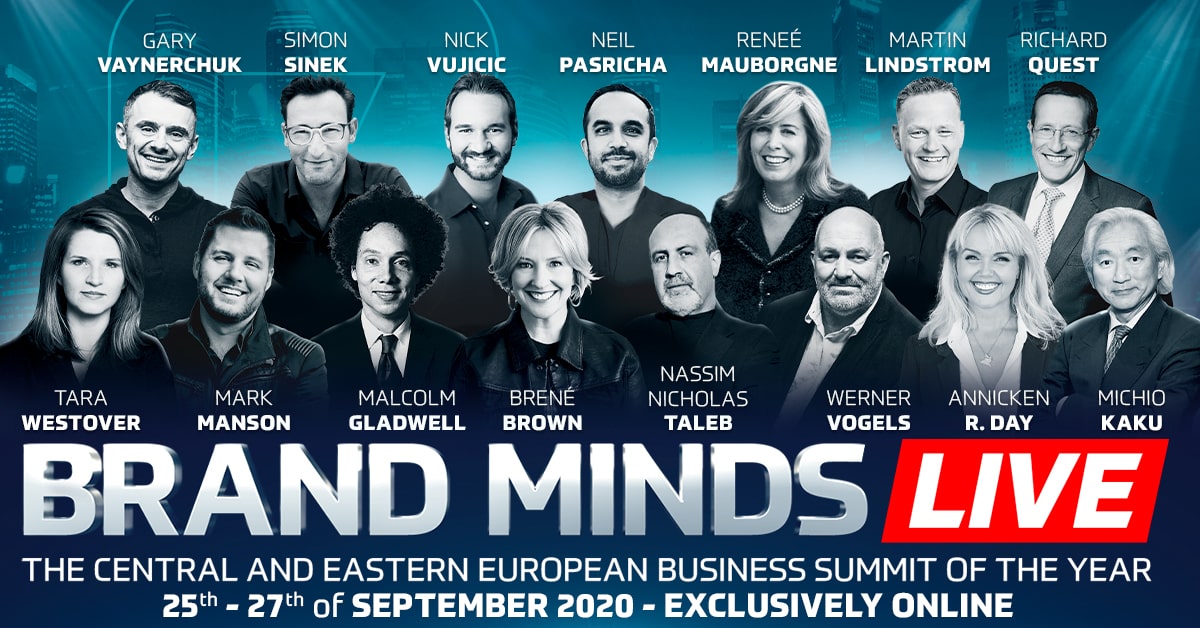
How AI transformed Amazon into an eCommerce powerhouse
Amazon is an eCommerce powerhouse. In 2019, the giant retailer is expected to hit a 52% market share in the US and almost 14% worldwide.
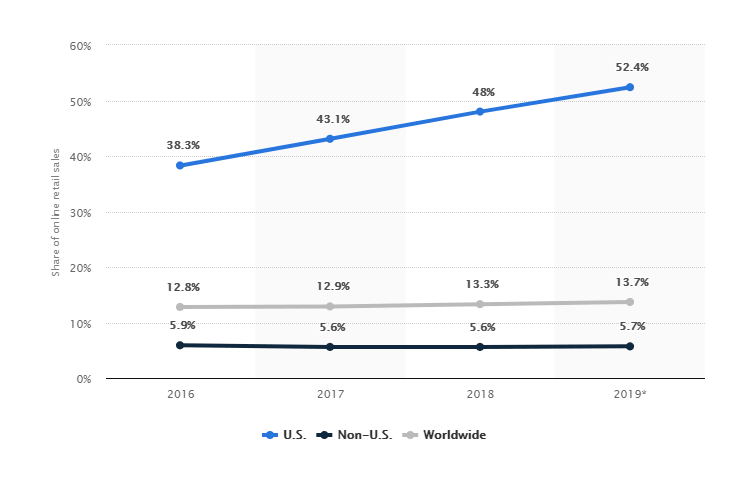
Amazon global market share 2016-2019 / Statista
Here are 6 relevant statistics which help paint a bigger picture and explain how Amazon dominates the American retail eCommerce:
- During July 2019, Amazon.com had almost 2.65 billion combined desktop and mobile visits, making the platform the most visited e-commerce property in the US;
- In 2018, the company reported total net revenue of $232.89 billion;
- For 2019, the biggest revenue segment were online stores with $31.05 billion in quarterly net sales;
- AWS, Amazon’s subsidiary that provides on-demand cloud computing platforms to individuals, companies, and governments is the platform’s second source of revenue in the amount of $8.3 billion;
- Amazon owns more than 90% market share in 5 product categories: Batteries (97%), Kitchen & Dining (94%), Home Improvement Tools (93%), Golf (92%), and Skin Care (91%) (source);
- Amazon Prime has over 100 million users and has generated $9.7 billion in subscription revenue.
AI is the foundation upon which Amazon grows its online sales and other services
From predicting how many customers might buy a new product to running Amazon Go, the cashier-less grocery store to assessing the quality of fruits and vegetables without smelling them for Amazon Fresh because humans are too slow and inconsistent.
Amazon’s AI capabilities allow the platform to provide customized recommendations. According to the latest reports, Amazon’s recommendation engine drives 35% of total sales.
With more than 100 million Alexa devices having been sold, Amazon’s smart speaker maintains a 70% market share in the US. In a statement on the last quarter of fiscal 2018, Jeff Bezos said Echo Dot was the best-selling item across all products on Amazon globally, and customers purchased millions more devices from the Echo family compared to last year (source).
In 2018, Amazon developers improved Alexa’s ability to understand requests and answer questions by more than 20% through advances in machine learning. Also, the number of research scientists working on Alexa has more than doubled in the past year, Bezos noted.
The giant American e-commerce retailer builds everything on AI because AI solves shoppers’ problems which in turn supports Amazon’s customer-centric approach.
The latest 4 AI-driven company operations and platform features
Aside from the recommendation engine, here are 4 of the latest AI-driven company operations and platform features:
1. AI optimization in the fulfilment centre
There are 1 to 4 million bins per fulfilment centre (warehouse) and on the order of 10 million items. In every fulfilment centre, computer vision systems analyze images to help Amazon staff keep track of everything.
Based on data, AI solves a large combinatorial optimization problem and decides which orders to pick at the same time in order to get them in the same box. This way the system minimizes the distance the transport pods have to travel.
AI optimization makes these decisions in real-time and with information that is constantly changing.
2. Machine learning for Amazon’s product graph
The giant retailer based its product graph on machine learning allowing it to describe every item using product and non-product concepts. The system also forms links between different entities, solving actual customer needs.
People don’t just come to Amazon to buy products. They visit Amazon to see what’s new or interesting, or to discover ways they can simplify and enrich their lives.
Xin Luna Dong – principle scientist on Amazon product graph
3. StyleSnap – AI-powered fashion discovery

StyleSnap is the latest Amazon AI-powered feature which supports fashion-focused shoppers.
How does it work?
The shopper takes a photograph or screenshot of a look that they like, upload it in the app and StyleSnap presents them with recommendations for similar items on Amazon that match the look in the photo. StyleSnap also considers a variety of factors such as brand, price range, and customer reviews.
4. Alexa is helping the blind with its latest feature, Show and Tell
As a customer-centric business, Amazon listens to customer feedback. The blind and visually impaired make up one category of Alexa devices customers. Amazon researchers have provided the smart speaker with a new feature designed to cater to the needs of the blind and visually impaired called Show and Tell.
Show and Tell allows the blind to identify grocery items by holding each item to the Echo Show camera and ask, “Alexa, what am I holding?”. The smart speaker identifies the item through advanced computer vision and machine learning technologies for object recognition.
To learn more about the ways Artificial Intelligence could improve e-commerce businesses, I reached out to Alin Neacsu, AI expert and CTO at Deqod and invited him to answer the following question:
Why should eCommerce sites leverage the power of Artificial Intelligence?
Here is Alin’s answer:
The eCommerce industry is witnessing a redefined form that takes customers to a new level of experience and gratification.
Contributing value to your customers is the only way to sustain, grow, and outshine your business rivals.
Brands now intensively should invest their money in exploring how AI can increase brand competitiveness, various processes, customer loyalty & at last, revenues.
Companies are implementing AI to cut service costs — resolving inbound requests via self-service and quickly answering customer questions through conversational AI and intelligent process automation.
Artificial Intelligence enables a business to understand its customers better and do so more quickly. This capability feeds into an improved overall customer experience using sophisticated email algorithms and automated chatbots.
Another crucial aspect where AI has proven to be of valuable assistance is cart abandonment. It helps expand customer engagement by reducing cart abandonment rates by a substantial extent using Facebook messenger, email, SMS or other channels on the site.
Consumers are often disappointed with eCommerce experience because the product results shown are often irrelevant. To tackle this problem, AI uses natural language processing to narrow, contextualize and improve search results for online shoppers.
Also, it allows having visual search capabilities, finding and matching products. Now, consumers can take a picture of a friend’s new shoes or a new shirt, upload it and then AI enables consumers to easily find similar items through eCommerce stores.
Knowing who your competitors are, and what they are offering can help product owners to make their products, services and marketing really stand out.
The big data tools powered by AI can help shop owners to monitor pricing patterns because frequent analysis of pricing patterns helps them stay competitive. Big data analytics allows them to compare their businesses with those of their competitors’ in just seconds and that can be used to increase the market share. More than 80% of enterprises believe big data analytics will redefine the competitive landscape of their industries within the next few years.
Artificial intelligence marketing is looking to change the game of leveraging customer data with newfound concepts of machine learning. Its purpose is to anticipate the next right move to enhance a customer’s journey which in my opinion is still far from being perfect.
How do you plan to use AI to help your company’s sales?
Let me know in the comments.
Join the Conversation
We’d love to hear what you have to say.
Get in touch with us on Facebook Group and Twitter.
Amazon’s new machines pack boxes up to 5x faster than humans
Amazon is trialling technology in its warehouses that can package orders five times faster than humans.
Check the video to find out!
Join the Conversation
We’d love to hear what you have to say.
Get in touch with us on Facebook Group and Twitter.











